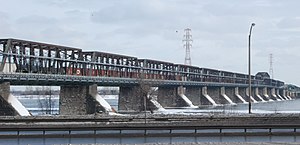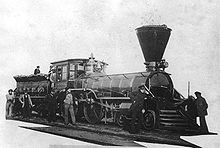Pont Victoria
Coordinates: 45 ° 29 ′ 29 ″ N , 73 ° 31 ′ 48 ″ W.
| Pont Victoria Victoria Bridge |
||
|---|---|---|
| use | Road and rail bridge | |
| Crossing of | Saint Lawrence River | |
| place | Montreal , Canada | |
| construction | Box girder / truss bridge | |
| overall length | approx. 2 km | |
| start of building | 1854/1897 | |
| completion | 1859/1898 | |
| opening | August 25, 1860 | |
| planner | Robert Stephenson | |
| location | ||
|
|
||
The Pont Victoria ( English Victoria Bridge ) is a railway and road bridge over the Saint Lawrence River in the Canadian province of Québec , which connects Montreal on the river island Île de Montréal with the opposite municipality of Saint-Lambert on the mainland.
The bridge, completed in 1859, was the first to cross the St. Lawrence River and was considered the longest bridge in the world when it opened. It was converted into the current bridge in 1898.
Surname
The bridge was originally named Great Victoria Bridge ( Grand Pont Victoria ) in honor of Queen Victoria , the head of state of what was then the province of Canada . During the renovation in 1897, the name was changed to Victoria Jubilee Bridge , in memory of the sixtieth anniversary of her accession to the throne. In 1978 one returned to the name Victoria Bridge or in the mostly French-speaking city to Pont Victoria .
Current bridge
Inside the truss girders, the steel truss bridge leads the double-track route for the trains of the Canadian National Railway on the Montreal - Halifax line as well as various local trains of the Agence métropolitaine de transport across the river. On the outside, a grating is built on both sides, each carrying one lane of Route 112 . During the rush hour in the morning and in the evening, traffic runs in one direction on both lanes.
The bridge, approx. 2 km long without the access ramps, not only crosses the river, but also the Autoroute Bonaventure ( Autoroute 10 ) and the parallel Chemin des Moulins on the Montreal side . On the opposite side, the Saint-Lambert lock in the Canal de la Rive Sud ( canal on the south bank ), a section of the Saint Lawrence Seaway built in 1958 to bypass the Lachine rapids , as well as the Autoroute René Lévesque ( Autoroute 20 ) and the Crosses rue Riverside . In particular, due to the construction of the bank canal and the lock, the stream became a little narrower, so that not all of the originally 24 pillars are in the river.
The lower end of the lock is crossed with a lifting bridge in order to give the Seawaymax ships the specified clearance height of 35.5 m. So that the traffic does not have to be interrupted, a truss bridge branching off approx. 550 m from the bank was built to the upper end of the lock for rail traffic, which is also crossed with a lift bridge. The lane for motor vehicle traffic is led over the branching railway with a solid wall girder construction. There are short ramps in front of the lock, which can be used to guide road traffic to and from a road along the lock area and finally to reach the other bank via the lift bridge at the upper end of the lock.
The next bridge upstream is the Pont Champlain motorway bridge and downstream the Pont de la Concorde / Pont des Îles between the port, the southern tip of the Île Sainte-Hélène and Île Notre-Dame and the Pont Jacques-Cartier over the Île Sainte-Hélène.
history
Box girder bridge (1859)
In the past, the St. Lawrence River could only be crossed by boat in summer, or on foot or horse-drawn sleigh in winter on the ice sheet that closed between December and March. In the transition periods, a crossing was out of the question because of the ice drift . A bridge was thought to be impossible for a long time until Thomas Keefer found a feasible route. The single-track bridge, commissioned by the Grand Trunk Railway, was not only particularly important for Canadian rail traffic and its connection with the USA, but also for the local population. The planning was done by Robert Stephenson together with Alexander McKenzie Ross , the chief engineer of the Grand Trunk Railway, who had previously worked with Stephenson in England. It was built from 1854 to 1859 by the English company Peto, Brassey and Betts . The bridge went into operation at the end of 1859, but was not inaugurated until August 25, 1860 by the Prince of Wales Albert Edward .
Stephenson used the same system that he had successfully implemented a few years earlier on the Conwy Railway Bridge and the Britannia Bridge in Wales , namely fully locked wrought-iron box girders through which the trains ran like a tunnel. However, the Pont Victoria was more than five times as long as the Britannia Bridge. The bridge had 25 openings, the middle of which had a span of 107 m (350 ft ) and the other 24 openings had spans of 74 m (242 ft). The box girders were riveted together on site from individual panels that were delivered from England. While the floor of the boxes for the railway had to be straight and horizontal, their roofs described parabolic curves, as was the case with the Britannia Bridge . The height of the box girders was reduced from 6.9 m (22 ft 6 ″) in the middle to 5.8 m (19 ft) at their outer ends. Iron with a total weight of 9433 t (10400 tons) was used for the hollow boxes.
The 24 piers were each 4.6 m (15 ft) thick, but the two middle ones were 5.5 m (18 ft). They were made of heavy stone blocks, the blocks being braced in addition to the mortar with iron bolts that were poured with lead. The striking, sloping flow dividers, which reached far into the upper water and served as ice breakers and had to withstand the often 9 m high, sometimes up to 15 m towering ice corridor, caused a sensation .
The bridge had a clearance height of 18.3 m (60 ft) in the main opening , which dropped to 11 m (36 ft) above the summer water level towards the banks.
After the Conwy Railway Bridge and the Britannia Bridge, the Pont Victoria was the third of the box girder bridges planned by Robert Stephenson - and at the same time the last of this system, which turned out to be too expensive. The Asnières railway bridge with hollow girders arranged under the tracks had already been opened in France in 1852 , but even this construction method could not prevail against the lattice girder and truss girder bridges at that time .
Truss Bridge (1898)
Due to the increased traffic, the bridge was converted into a double-track steel truss bridge between 1897 and 1898 . With traffic moving, the new, much larger trusses were built on the only slightly changed pillars around the box girders, which were then dismantled.
Additional junction (1959)
In 1959, the two lift bridges over the lock exits and the railway branch to the upper lift bridge were built during the construction of the St. Lawrence Seaway with the bank canal and the Saint-Lambert lock. For this purpose, a switch structure made of solid wall girders had to be installed in the river , which are supported on additional pillars.
Web links
- Pont Victoria on Montreal Insites (with several historical photos)
Individual evidence
- ^ A Canadian: The Victoria Bridge, at Montreal, Canada. London 1860, p. 7 f ( digitized on Google Books)
- ↑ The Victoria Bridge near Montreal. In: Zeitschrift für Bauwesen, Volume VIII, 1858, p. 489 (on zlb.de)
- ^ Victoria Bridge near Montreal. Plan sketches. In: Atlas zur Zeitschrift für Bauwesen , Volume X, 1860, Sheet 58–60
- ^ The Victoria Bridge, Montreal . In: The Civil Engineer and Architect's Journal , Vol. 23, London 1860, pp. 157 f, 250 f ( full text in Google Book Search and full text in Google Book Search)






